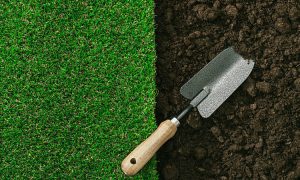Why Are There Holes in Your Lawn?
When you find a hole or holes in your lawn, your first question should be, why? Because there are different signs for wildlife or insects, and holes in your lawn could be one of them. This guide will help tell you what to look for.
Guest post by Mike Fitzgerald
When you find a hole or holes in your lawn, your first question should be, why? Because there are different signs for wildlife or insects, holes in your lawn could be a sign of infestation. This guide will help tell you what to look for.
In Hardiness Zone 9b, Orlando, FL, a hole in the lawn can mean many things. It could be caused by a vole, gopher, turtle, or even an armadillo. So, to figure out what is messing up the lawn, some questions need to be asked:
- What is the shape and size of the hole?
- Does the hole lead to a tunnel or burrow; or is it just a hole in the ground?
- Does the hole have loose dirt around it or does it appear clean?
- Do you see any other piles of soil, small hills, or mounds anywhere else in the yard?
- Do you see any damage done to grass or plants that are shredded, or chewed?
Once these questions are answered, then what is causing the holes can be narrowed down.
When It’s a Hole
When discovering a hole, it can be a pretty good sign there’s wildlife causing disturbances around your home. The average yard size in Orlando is 7,741 square feet, making it understandable to overlook certain areas of your lawn. One or two holes may not be too much of an issue, but if there are quite a few holes and burrows, then you need to figure out what’s doing it. Looking closely at the soil disturbance for their size, location of where they are, and the shape can help you determine why there are holes.
If the holes are about 3 inches in diameter and there are one or two, then it could have been dug by voles, chipmunks, snakes, or Norway rats. If the hole is 6 to 12 inches around and is near logs, walls, or trees, then it could be a skunk, red fox, coyotes, or an armadillo. If any tracks can be seen coming in or out of the hole, or if there’s a skunk odor, it can narrow down the culprit.
Another 6- to 12-inch diameter digger is the gopher tortoise. If it is this fellow, then there will be a significant mound of sandy soil in front and around the hole. They dig a large burrow underground, and the entrance is wider than it is tall. This is to fit the shell of the tortoise into the hole.
A pocket gopher is otherwise known as “sandy-mounders or salamanders.” They live underground and dig tunnel systems below the surface of the soil about 6 to 12 inches in circumference. The pocket gophers take the dirt out of the tunnel systems and pile it into crescent-shaped mounds that are asymmetrical. Instead of an easily seen entrance hole, there is a soil plug to the side of the center of the heap. They are herbivores and will eat the roots of plants as well as parts of plants.
Getting Rid of the Problem
Once you figure out what is digging the holes, then you’ll have to take measures. One way is to make the lawn less inviting for a critter infestation. This can be done by keeping the yard cleaned up, mowed, and weeded to make it difficult for hiding places to be found. Avoid putting mulch in piles against tree trunks and shrubs too.
Traps can also be set according to what species of pest you’re dealing with. Scissors or spear traps placed at an intersection of a mole tunnel will catch a mole. But, it needs to be placed at the entrance of a burrow to catch a gopher. Toxic bait traps are an option, but they can harm dogs and cats as well. Also, any trap that can catch an animal may be a curiosity to a pet, which can mean they will be harmed or killed.
Another method, if you’re not sure what is digging the holes, is to draw the pest out of the holes by watering lightly to keep the grass alive, but the soil (which is deeper) dry. This cuts back on the food supply, and they’ll be forced to leave their holes and burrows. If you invite predators into your yard, such as barn owls (by erecting a shelter), or even releasing gopher snakes, this will help cut back on the rodent population. These animals will kill small pets too though.
Finding out what it is digging holes in the lawn is only half the battle; the other half is dealing with whatever is doing the digging.
Mike Fitzgerald is an outdoor living expert and explorer. When he’s not traveling to nature’s most well-known beauty spots, he tends to the greenery surrounding his home.
[cf]skyword_tracking_tag[/cf]




